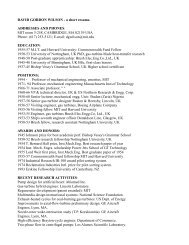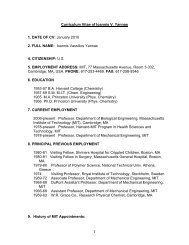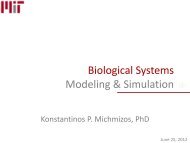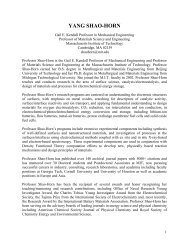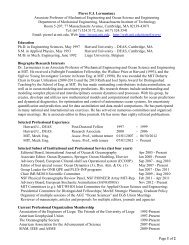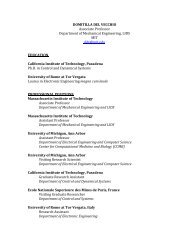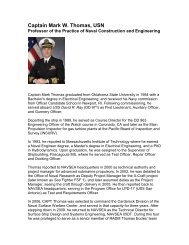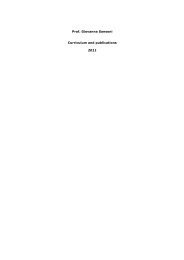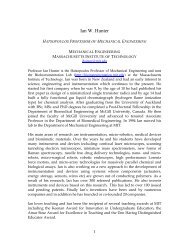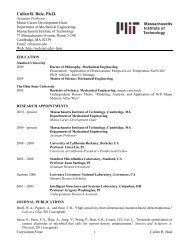Compound Noise - MIT Department of Mechanical Engineering
Compound Noise - MIT Department of Mechanical Engineering
Compound Noise - MIT Department of Mechanical Engineering
You also want an ePaper? Increase the reach of your titles
YUMPU automatically turns print PDFs into web optimized ePapers that Google loves.
390 J. SINGH ET AL.<br />
improvement to maximum possible improvement is called the improvement ratio. The average <strong>of</strong> this measure<br />
for all replicates is shown in the eighth column <strong>of</strong> Table I.<br />
From Table I we can see that compound noise strategy works reasonably well for the Op Amp, PNM, journal<br />
bearing and slider crank, but not nearly as well for the CSTR and the temperature control circuit.<br />
CONDITIONS FOR COMPOUND NOISE TO BE COMPLETELY EFFECTIVE<br />
Hou 5 gave conditions under which a compound noise strategy will predict the robust setting for a system.<br />
One <strong>of</strong> the conditions for compound noise to work is the existence <strong>of</strong> extreme settings. The extreme settings<br />
<strong>of</strong> compound noise are those that maximize and minimize the system’s response to capture noise variations.<br />
However, we found that in some systems (e.g., PNM; Tawfik and Durand 13 ) the compound noise strategy would<br />
work even if extreme settings do not exist. So the conditions outlined in Theorem 4 <strong>of</strong> Hou 5 are sufficient but<br />
not necessary conditions for compound noise to work.<br />
For strong hierarchy systems the response y can be expressed as<br />
m∑ m∑<br />
y = f(x 1 ,x 2 ,...,x l ) + β j z j +<br />
j=1<br />
j=1 i=1<br />
l∑<br />
γ ij x i z j (1)<br />
where f(x 1 ,x 2 ,...,x l ) is a general function in the control factors x i ,z j (j = 1,...,m)denotes the noise<br />
factors affecting the system, β j denotes the effect intensity <strong>of</strong> noise factor j and γ ij denotes the effect intensities<br />
<strong>of</strong> control-by-noise interactions present in the system. Control factors can have two settings, either −1 or1.<br />
(Control factor variability can be represented as separate noise factors.) <strong>Noise</strong> factors are in the range −1 to1<br />
and are independent, with zero mean and a variance <strong>of</strong> 1. <strong>Noise</strong> factors are symmetric about 0. The variance <strong>of</strong><br />
y with respect to z j termsisgivenby<br />
( l∑ ( m∑ )<br />
Var z (y) = C + 2 β j γ ij x i +<br />
i=1 j=1<br />
l∑<br />
( m∑ )<br />
γ ij γ kj<br />
)x i x k<br />
j=1<br />
where C is a constant. The robust setting <strong>of</strong> the system is such that the variance <strong>of</strong> the response is minimized<br />
with respect to noise factors. It can be represented as<br />
[ ( l∑ ( m∑ ) l∑<br />
( m∑ )]<br />
X ≡ arg min β j γ ij x i + γ ij γ kj<br />
)x i x k (3)<br />
x i<br />
i=1 j=1 j=1<br />
where X is the setting <strong>of</strong> the x i terms that minimizes the variance.<br />
If we follow Taguchi’s formulation <strong>of</strong> compound noise, based on the directionality <strong>of</strong> noise factors, then<br />
responses at two levels <strong>of</strong> compound noise will be given by<br />
m∑<br />
( l∑<br />
y + = f(x 1 ,x 2 ,...,x l ) + β j + γ ij x i<br />
)sign(β j ) (4)<br />
y − = f(x 1 ,x 2 ,...,x l ) −<br />
j=1<br />
k=1<br />
i



